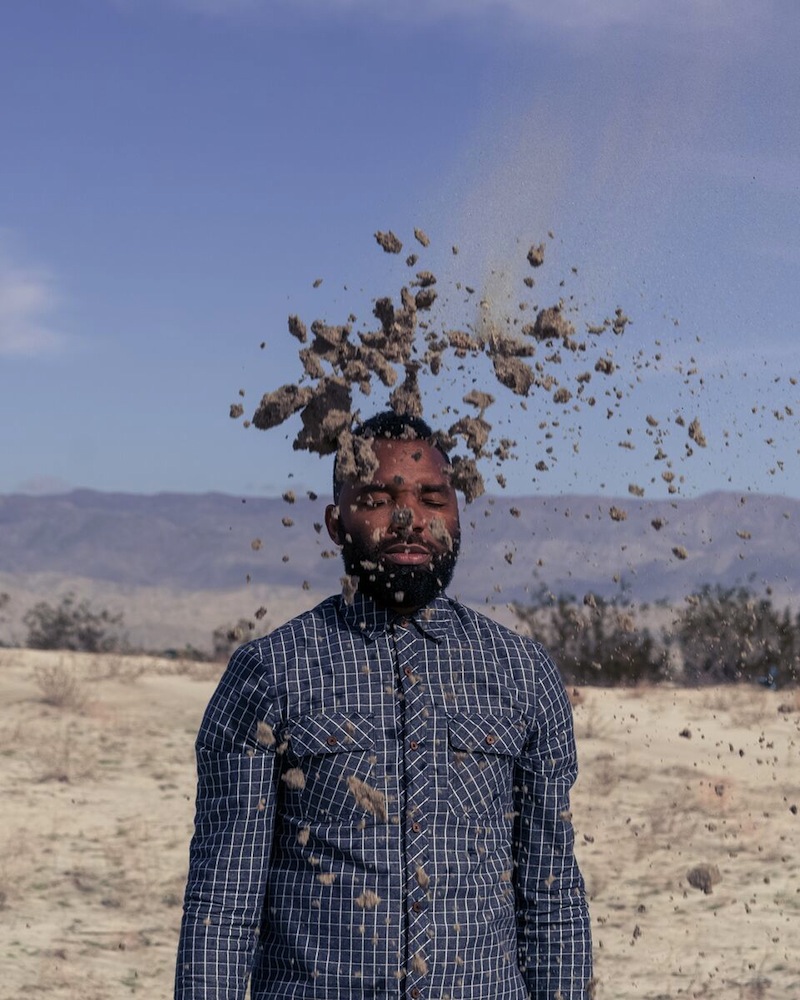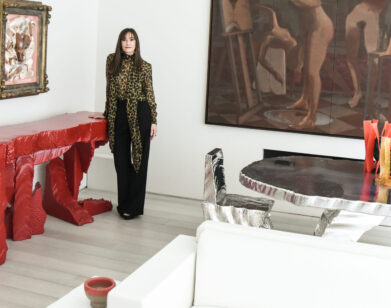Tavares Strachan’s Desert Explosion
Along a desert road in Rancho Mirage, California, Tavares Strachan, the 37-year-old multidisciplinary artist, has installed some 290 craters of neon light, which from above spell the words “I am.” It is a fittingly provocative and unabashed work for the artist, who’s spent the better part of his career exploring the tension between what we see on the surface versus what lies below; our relationship to place; and our perceptions of self. Consider one of his most famous works: 2006’s The Distance Between What We Have and What We Want, in which he excavated a four-ton block of ice from the Alaskan Arctic, then shipped it to his childhood elementary school in the Bahamas, where it lived in a cooler (and has since traveled to further locales). That was a meditation on displacement—something Strachan has carried with him ever since leaving home for the States—but its ambitious conceit points to a flair for spectacle.
I Am is part of Desert X, a new exhibition of 16 site-specific works spread across the Coachella Valley, which opened this past weekend and runs through the end of April. Some of the works in Desert X interact with the landscape by attempting to disappear into it: Doug Aitken covered a house in mirrors, reflecting back the ground and sky; Will Boone submerged a bunker deep underground. In the secluded Whitewater Preserve, Sherin Guirguis built a structure out of soil and clay, which will slowly erode and return to the earth. Strachan’s, on the other hand, springs forth from the land and announces itself. It is so big—100,000 square feet long, or the length of two football fields—and bright, people in airplanes can see it, the words seeming to explode outwards like a firework. From the ground, the piece takes on a different but no less otherworldly quality, with the pools of light arranged like stepping-stones. It’s here that the piece’s softer side is revealed.
A few weeks ago, ahead of the exhibition’s opening, Interview reached Strachan by phone to discuss the installation process and his hopes for I Am.
MATT MULLEN: In a lot of ways Desert X seems fitting for you: much of your work deals with climate, exploration, desolation, and isolation—which are all things I think of when I think of the desert. Did you feel the same way? Or did you have to grapple with this new environment?
TAVARES STRACHAN: I think there’s an interesting line drawn towards extreme environments, and the way I define extreme is through a sense of otherness. Or foreignness. If you take a flower to Mars, for example, the hostility of Mars probably won’t allow the flower to live without oxygen. The process of being an artist, for someone who wasn’t born in an arts-centric environment—I came from the Bahamas, where there’s not a historic tradition of art-making, at least from the Western prospective—in a way is kind of an alien concept. So my approach to making, it borrows from that idea and allows me to take on the idea of the foreign or the strange or the alien.
MULLEN: And you’re not daunted by it, you’re saying.
STRACHAN: No. I think being an artist and taking on those challenges is just how it is for me. Because I was always a foreigner, I was always the outsider. The idea of being in the desert is fundamental, but it’s totally relative, and it’s about that membrane: the way that one defines self versus the environment. And whether you’re a foreigner in that environment in relation to self, or whether you’re indigenous to that environment.
I think the projects that I work on are very challenging, in some ways by pure ambition and desire, and so those are very distracting conditions. Like I was saying earlier, it allows for a certain freedom. So I don’t really feel pressure. I’m so distracted by what we’re doing; I’m doing this four-acre project, it’s just absorbing all my attention. Before you know it we’re onto the next project, and so on and so forth.
MULLEN: Can you walk me through the timeline of this project?
STRACHAN: We started the conceptual process about two years ago in New York. And then it developed and developed over that two-year period to about one year later, and then we started conceptualizing what it would take to make the work, and then we began making it. I’ve been going back and forth to Palm Springs for the past six months.
MULLEN: How did you get involved with Desert X; who initially approached you and what were your initial reactions?
STRACHAN: I was approached by Neville Wakefield. I’ve known Neville for almost a decade, but we had never really worked together. We sort of threatened to work together on a number of other projects but never really did. In a weird way we took the understanding that the project itself was going to be a pipe dream, because the reality is projects like this very rarely get produced. So it was very freeing in the beginning, because there was this underwritten impossible layer to the project. And in a way I think that reality, that realization, allowed the project to actually move forward. It’s kind of counter-intuitive.
MULLEN: When was the moment you realized it wasn’t a pipe dream anymore?
STRACHAN: The majority of the things we work on in the studio are pipe dreams. I think it allows us to relax and just simply get to work. It’s so unreasonable that you succumb to the task of it. And then there’s always a moment that tilts the scales of the project, and it’s always different in every project. In this project I believe it was the moment we were able to acquire the land to install the work on, which is privately owned.
MULLEN: Do you work on one project at a time or do you dabble?
STRACHAN: Because the projects have such long timelines, many of them, we’re working on several of them at once. But the past six months I’ve been totally focused on I Am.
MULLEN: Do you like to be totally immersed like that?
STRACHAN: I think it’s every artist’s nature to want to escape. It’s also human nature in a way, depending on your personality, to want to get away from it all. I think when you’re younger and making things, it’s something that you have to fight through, to finish things. I feel like I’m past that stage, and I get the appreciation for being in that moment, and soaking it in.
MULLEN: The idea of escape is interesting. You talked to one magazine about how your thoughts always used to be about getting off the island where you came from. Is that mentality still there in your work, or has it dissipated as you’ve grown?
STRACHAN: It’s funny that you mention that. The way that I Am is designed, it becomes a kind of archipelago, which the Bahamas are. When you’re in it, it feels like a bunch of islands, with keys and things like that. It’s an existential archipelago. It’s funny, you try to escape who you are and where you’re from, but it’s always part of your social DNA. And also your biological DNA. It always seeps through somehow.
MULLEN: And then maybe in the process of trying to escape it, interesting stuff comes out.
STRACHAN: Totally. Exactly.
MULLEN: You’re using neon here, which of course you’ve used before. Why did you return to it this time around?
STRACHAN: I think it was driven from practicality. There are certain conceptual powers in this project, like the relationship of glass to sand, and the idea of putting glass back into the earth, which is where it comes from, which are related to the whole concept of I Am. So there’s that one below-surface idea, and then there’s these other practical and more pragmatic ideas about how the light functions and the geometry and mathematics behind the reverberation of light from the surface outward. It allows this material to speak more specifically to the experience of being in these pools of light and being overwhelmed by physiological experience.
MULLEN: For you, is the concept informed by material or does the material come after?
STRACHAN: I think it’s different for every work, and it’s a case-by-case situation. Sometimes I’m inspired by the material and sometimes there’s an idea that speaks to a material. I was looking at star clusters and island formations, and the origin of things, in a way—Big Bang theories and explosions, etcetera. So wanting to create this experience, like if you were going to be inside of an explosion, or standing in the middle of a pool of inverted islands with light, that’s where I was going. So I turned to neon. We’re right in the flight line of the airplanes. A lot of the planes coming in over Palm Desert will see it.
MULLEN: Working on such a durational piece, and in a totally new environment, have you made any discoveries about yourself or your relationship to the landscape?
STRACHAN: I think the biggest takeaway thus far is the contemplation of time. I think this has been a really nice way to look at time on a macro scale and a micro scale. I’m working on this project, and it’s the most important thing to me at this particular moment. And when you look at that in the context of the desert, which many, many millions of years ago used to be ocean floor, it’s actually a really dichotomous situation, to put things into a larger perspective. It’s a really great spiritual headspace to be in.
MULLEN: Have you been finding inspiration for future projects?
STRACHAN: Usually that happens, but this installation, the scale of it, has been totally all-consuming.
MULLEN: What is your research process like, generally speaking?
STRACHAN: I think it starts with some sort of poetry-driven influence. And it ranges from really simple ideas to really complex ideas involving geopolitics or science or something like that, because in a way those two worlds represent my upbringing: I was born in a small clapboard house on an island, but I also have certain privileges that I didn’t have when I was on the island. So that dichotomy again is actually really crucial.
MULLEN: What do you mean by poetry-driven?
STRACHAN: Poetry makes sense of the parts of human experience that are confusing and not decodable in any other way. It makes accessible the inaccessible. I think if art has one underlying value, it’s that. It reminds us that there are things we don’t know, and in that not knowing, we find strength.
I AM IS ON VIEW IN RANCHO MIRAGE, CALIFORNIA THROUGH APRIL 30, 2017 AS PART OF DESERT X.







